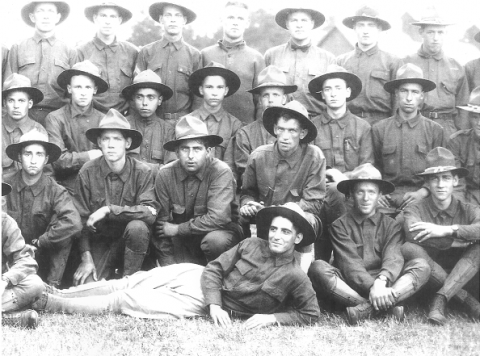Wed, 07/18/2018 - 9:22am

Dilboy is a familiar name our city: Dilboy Field in West Somerville, the Veterans of Foreign Wars Post 529 – Dilboy Post - on Summer Street; the statue of Dilboy by City Hall. He was killed in action on July 18, 1918, near Chateau Thierry, France, and awarded the Medal of Honor for bravery posthumously. In May of this year, he was honored along with other World War I veterans at the Chateau-Thierry American Monument in France, where the American Battle Monuments Commission launched an interactive exhibit in its visitor center. In the photo above, Dilboy is the one reclined in front, with his fellow soldiers at Camp Keyes in Concord, NH. (photo from Richard Rozakis's The Story of George Dilboy, in our Local History room). Here, we remember him on the centennial of his death. This year also marks a century since the end of World War I.
George Dilboy was a Greek-American who immigrated to Somerville in 1910, and lived in Brickbottom on Linwood Street at the corner of Poplar. In 1912, at the tender age of 16, he returned to Greece to fight for his native country in the First and Second Balkan Wars. He returned to Somerville in the spring of 1915, and by the next summer decided to enlist in the New Hampshire National Guard, become an American citizen, and fight for the U.S. during the Mexican Border War. He was only back in Somerville a short time before his unit, which became known as the “Yankee Division” was called to serve in France in September, 1917. On July 18, 1918, Dilboy was killed in action countering the last German offensive of the war – the Aisne-Marne counter-offensive, which occurred near Chateau Thierry, and ultimately forced German withdrawal.
The Medal of Honor of the United States Army (1948) described Dilboy’s last battle:
“After his platoon had gained its objective along a railroad embankment, Pfc. Dilboy, accompanying his platoon leader to reconnoiter the ground beyond, was suddenly fired upon by an enemy machinegun from 100 yards. From a standing position on the railroad track, fully exposed to view, he opened fire at once, but failing to silence the gun, rushed forward with his bayonet fixed, through a wheat field toward the gun emplacement, falling within 25 yards of the gun with his right leg nearly severed above the knee and with several bullet holes in his body. With undaunted courage he continued to fire into the emplacement from a prone position, killing 2 of the enemy and dispersing the rest of the crew.” He was awarded the Medal of Honor, the highest military award for bravery at the risk of life above and beyond the call of duty.

Add new comment